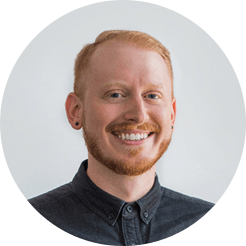What makes a good content marketing strategy?
Is it a great idea for a webinar? Some solid blog post topics? A hilarious ad on social media that hopefully goes viral?
Though yes, all of the above could be considering content marketing, none of them constitute a content marketing strategy.

Strategy is all about setting aside the time to plan, concoct and cull ideas, and importantly, ensure your content marketing efforts align with your core business goals. What you’re doing is creating a roadmap into the future.
And like any good road trip, you’ve got to put a bit of time into planning your itinerary.
Which routes are you going to take? Where will you take a pitstop? Which attractions are you going to tick off the bucket list?
Before you even get there though, you’ve got to start with the destination.
Content Marketing Template - Step by Step
Before you dive headfirst into creating a content marketing strategy, it’s wise to take stock of where your business is at currently.
Setting Content Marketing Goals
That starts with revisiting your company’s overall goals and objectives, as well as your more specific marketing goals. If you don’t have any marketing objectives, that’s okay, but you’ll need to spend some time setting some goals before you go any further.
This is vital because if you aren’t clear on your business and marketing goals, you won’t be able to assess the efficacy of your content marketing strategy.
Goal Setting Template
Start with your core business goal for the year. You probably have a few, but you also no doubt have an overarching objective, which might be something like “Grow Annual Revenue to $3m”.
From there, identify three specific marketing objectives that will contribute to that overarching goal. For growing annual revenue this might look like:
- Increase inbound leads 25%
- Grow average customer value from $1500 to $2500
- Lift prospect close rate from 40% to 50%
Now you have three highly specific marketing goals, to which you can align your specific content marketing strategies, which would look something like this.
Main Business Goal (Grow Annual Revenue to $3m)
|
Increase inbound leads 25% |
Grow average customer value from $1500 to $2500 |
Lift prospect close rate from 40% to 50% |
|---|---|---|
|
Content Marketing Goal 1 e.g. Grow blog traffic 80% |
Content Marketing Goal 1 e.g. Focus CM efforts to higher-value customer persona |
Content Marketing Goal 1 e.g. Educational lead nurturing program |
|
Content Marketing Goal 2 |
Content Marketing Goal 2 |
Content Marketing Goal 2 |
|
Content Marketing Goal 3 |
Content Marketing Goal 3 |
Content Marketing Goal 3 |
Content Marketing Strategies
When it comes to picking your content marketing strategies, you’ve got a lot to choose from. The good thing is, there are a few tried and true tactics. These are our five favourites:
- Blogging
- Content offers
- Social media marketing
- Website hierarchy and architecture
- SEO
Blogging
Blogging is without a doubt the most popular of all content marketing techniques. It's incredibly effective, whether you’re in a B2C or B2B environment.
The point of blogging is to provide incredible value, offering actionable insights that your potential customers can take away and put into practice. Take this post as an example, it’s filled with tactics and strategies that you can use to grow your business right away.
The logic behind blogging is this: if you can consistently provide real value to your prospects, they’ll begin to see you as a trusted advisor. Eventually, when they need the product or service you offer, they’ll turn to you to help them solve their problem. Blogging is a fantastic example of Awareness stage content marketing (you’ll learn about this shortly). One critical aspect of a successful content marketing strategy is the creation and use of templates that can enhance efficiency. You can tailor custom templates to your unique brand identity and requirements, providing consistency across various content platforms. By implementing tailored design solutions, businesses can maintain a cohesive appearance which reinforces their brand recognition.
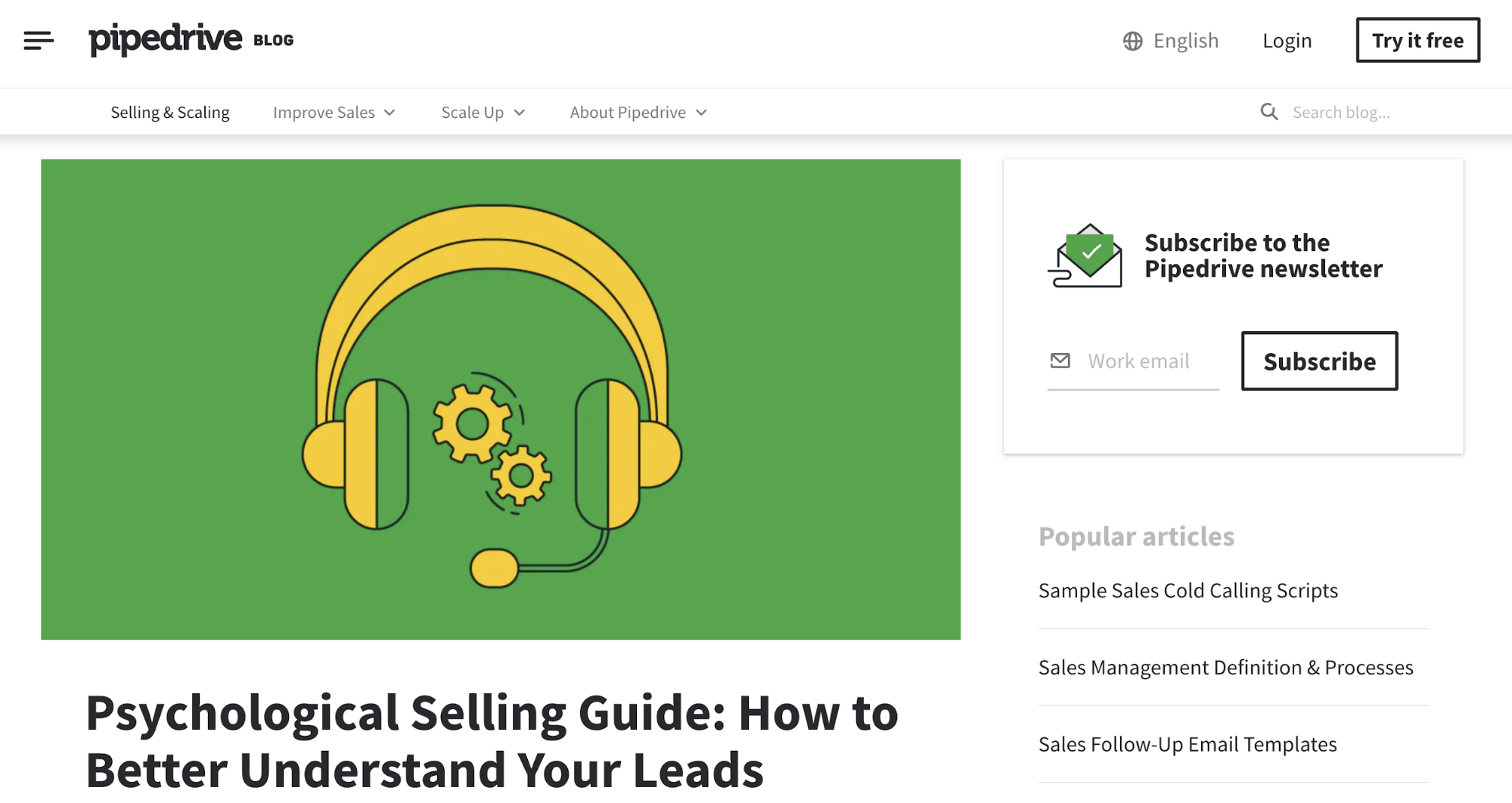
Image source: pipedrive.com
Content Offers
Blogs aren’t the be-all and end-all of written content, however. Other common types of content marketing include:
- Whitepapers
- Guides
- eBooks
- Checklists
- Case studies
Each of these has a specific purpose, though they are all designed to educate the customer, whether that be about a wider issue or about your company in particular.
Rather than give them away, though, successful content marketers often use these types of content to create what is known as a content offer. Also referred to as gated content or content upgrades, content offers are given to a prospect in exchange for contact details, typically an email address.
This is a fantastic way to generate leads, that you can then nurture via email marketing.
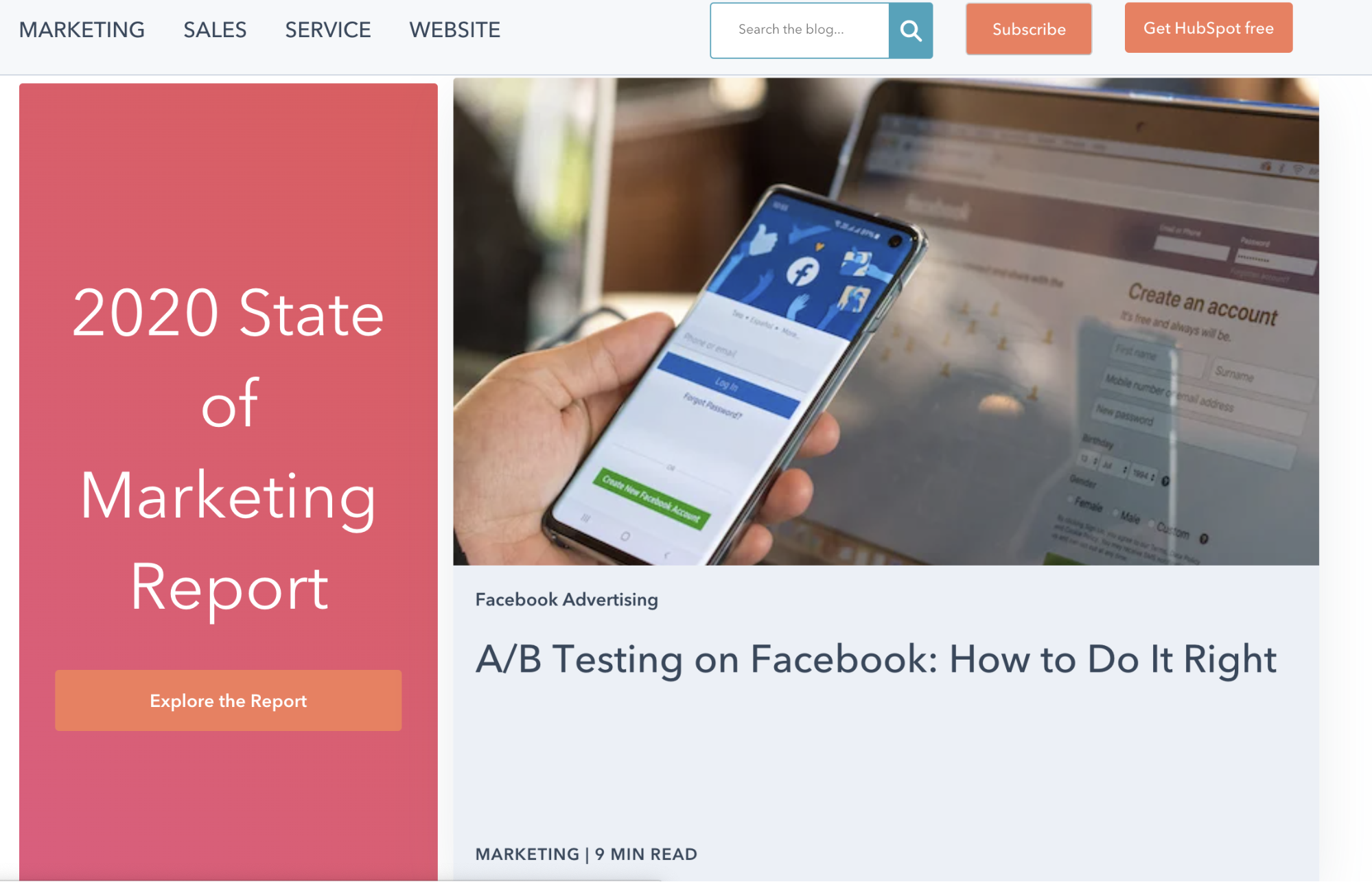
Image source: hubspot.com
A common technique is to display content offers on blog pages, the logic being that the prospect is already interested in what you’re telling them, and so they are likely to be willing to hand over their email address for a content upgrade.
Social Media Marketing
Social media content marketing is an absolute beast to tackle, but if you get it right, it can skyrocket your lead generation.
There are two main types of social media marketing, paid and organic.
Organic social media marketing refers to simply making posts on your page, engaging your base of followers (and hopefully those that they might share your posts with). This can be effective when you’ve got a decent audience, but if you’re just starting out, you might want to look at some paid social activities.
Paid social media marketing is all about sponsored ads and boosted posts.

It’s a complex world, but at a super high level it involves:
- Setting your audience parameters
- Deciding on a weekly spend (budget)
- Determining the content that will be displayed (video, blog post, banner ad)
- Careful and regular monitoring and tweaking of the ad
Paid social media marketing costs money, so it’s important that you set up your ads with the goal of turning that spend into revenue.
A popular way of doing this is using a content offer such as a free eBook or checklist.

This will typically yield you an email address for further lead nurturing. Another option would be to sponsor a blog post or case study that sits on your website, with the aim of having ad viewers click through to your site.
This will increase your website traffic which can in turn improve your search rankings. It’s important though that your website is set up to generate leads. If not, you could be sending prospects there without giving them an action to take, and you’ll miss out on the opportunity to capture a lead.
Website Layout
Just like there’s more to website design than a nice logo and a pretty color palette, there’s more to writing website content than just hitting keywords for SEO.
You need to ensure that your website is laid out in a way that guides visitors down a specific pathway. When someone first lands on your site, they’ll typically scan the page in Z-like fashion:
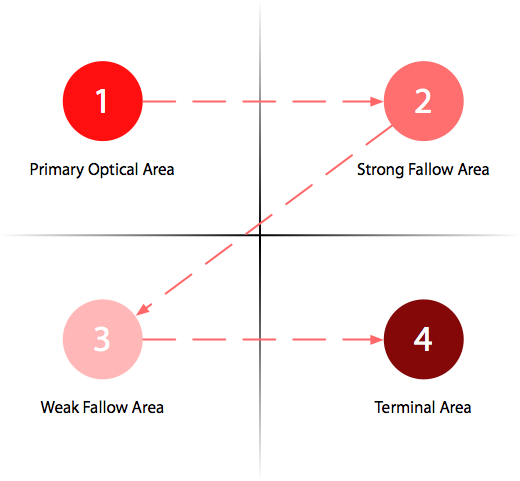 Image source: cxl.com
Image source: cxl.com
You need to place content offers and call-to-actions in this zone, ideally in the Terminal Area.
Image source: marketo.com

Take Marketo’s homepage, for example. There is a clear user pathway here, the top navigation bar is clearly laid out, which is the top horizontal line of the Z shape. At the apex of this line (top right-hand corner), a content marketing CTA is placed (View a product tour).
If that doesn’t capture the viewer’s attention, then it’s likely they’ll follow the diagonal line down to the bottom left corner. This pathway crosses another CTA, encouraging prospects to view a report on CRM lead management (content offer). Lastly, we have another CTA (Watch now) in the terminal area.
SEO
Search Engine Optimization is a big fish to fry, but that doesn’t mean you should shy away from it. SEO is generally attacked from three angles:
- Technical SEO
- On-Page SEO
- Off-Page SEO
Technical SEO is all about the architecture and back-end of your website. Off-Page SEO mostly refers to links from other websites that direct traffic back to yours.
On-Page SEO is where the good meat is, from a content marketing perspective.
On-Page SEO is all about the words on the page, whether that be a landing page, blog post, or case study.
To maximize your SEO efforts, you’ll want to be targeting specific keywords and key search phrases, weaving them into your content effortlessly. The last thing you want to do is stuff your content with keywords or try to fit them in unnaturally.
You’ll also want to make sure that your content is rich with semantically related keywords, that is, words that are related to the main keyword, but not synonyms of it. If your content is truly valuable and relevant to the key search phrase, it’s likely that this will happen by proxy.
Identifying the right keywords and phrases to include in your content marketing is one of the best methods of getting traffic to your blog.
The best way to determine the right content marketing strategies for your company is to choose the tactics that best reflect your marketing goals.
|
Content Marketing Strategy |
Suitable If Your Marketing Goals Include |
|---|---|
|
Blogging |
|
|
Content Offers |
|
|
Social Media Marketing |
|
|
Website Layout |
|
|
SEO |
|
Keyword Research
If you’re writing anything for the web, whether it’s a landing page, a blog post, a case study, or even your company ‘about’ page, you need to be thinking about keywords.
At a high level, the keywords you include in your content determine how search engines index your web pages. Search engines like Google have bots that crawl pretty much every single page on the web, and they scan the text on your page to determine what it’s about. If your content makes use of the phrase “sales CRM” several times, as well as associated semantically related words (inbound, sales rep, automation, contacts, leads, etc), then Google will safely assume the page is about some form of sales CRM.
Bear in mind that the world of SEO, content writing, and keyword use is a fair bit more complicated than that, so view this as a general rule. You should also be careful not to go too hard on the keywords, as stuffing a page of content with the same phrase can become unnatural, and won’t do you any favours in the long run.
So, how do you know which words you need to include? That’s where your keyword research comes in.
Keyword research is the process of using some form of software (Moz, SemRush, Google’s Keyword Planner), to determine actual search volumes for specific phrases, and making decisions based on those volumes as well as ranking difficulties.
To perform keyword research for your content marketing strategy, just follow these steps:
|
Step 1: Make a list of relevant topics |
|
|
Step 2: List out keyword ideas under those core topics |
|
|
Step 3: Identify related search terms |
|
|
Step 4: Make sure you have a mix of head terms and long-tail keywords under each core topic |
|
|
Step 5: Do some market research |
|
|
Step 6: Cut down your keyword list |
|
|
Step 7: Collate similar results |
|
Mapping Content Against Customer Journey
Now that you’ve got a solid list of keywords, you’re almost ready to start creating content. Before you do though, you need to consider the typical customer journey.
Every single buyer, whether a business buyer or a regular consumer, goes through a process when making a buying decision. A simplified version looks like this:
- Awareness - the customer has recently become aware of a problem or challenge
- Consideration - the customer is assessing their option for solving the issue (including doing nothing at all)
- Decision - the customer has narrowed it down to two or three option, and is primed to buy
The content that your company creates needs to be targeted towards customers that are in different stages of the buying process. Prospects in the Awareness stage are absorbing a vastly different type of content than those in the Decision stage. Use this guide to determine which content types to use and what kinds of messages to instil across the customer journey.
| Customer Journey Stage | Goal | Content Types |
|---|---|---|
| Awareness | Educate the prospect on a given challenge |
|
| Consideration | Demonstrate how your company solves said challenge |
|
| Decision | Convince the prospect that your product/service is the best option |
|
Content Marketing Planner
The most successful content marketing strategies are ones that are planned months in advance. Coming up with blog post ideas at a moment’s notice isn’t going to deliver the goods, you need to know where you’re heading and follow that path. That involves creating a content planner.
A content planner outlines
- The types of content that are going to be created
- When they are to due to be completed
- The objective of each content asset
- Who is responsible for creating that content asset
- Where and how the asset is going to be deployed
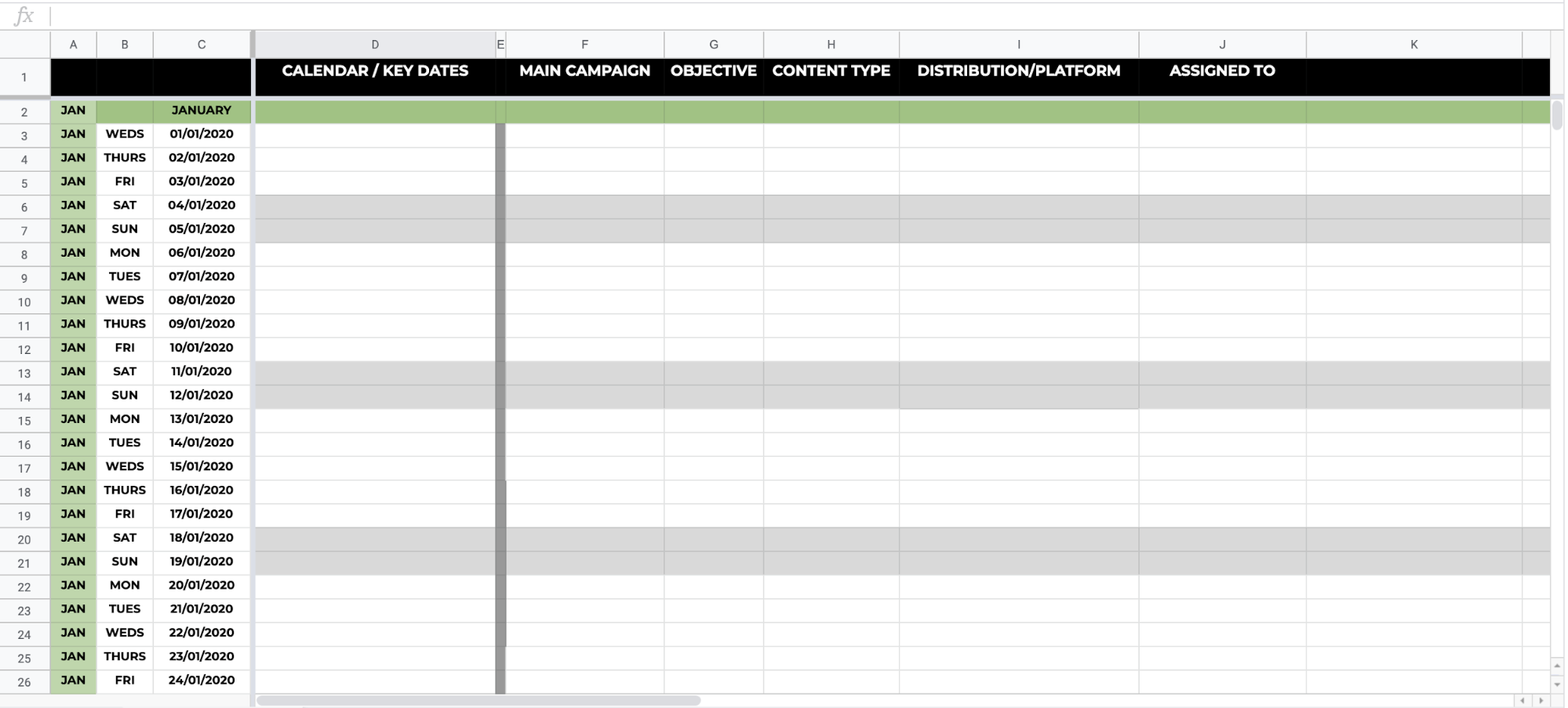
Some content marketers will plan as far as 12 months in advance, though 3-6 months is usually a good guideline. This gives you the ability to assess your efforts and make any changes as necessary.
Content Audit
Even if you’re only just getting started on your content marketing journey, chances are you already own some content assets.
At the very least, you probably have a website. You might even have a couple of blog posts, or some marketing collateral (whitepapers, case studies) that supports your sales team’s efforts. The good news is, all of this constitutes the beginning of your content marketing strategy.
Once you’ve spent some time researching appropriate keywords, and distributing them over the course of several months in your content planner, you’ll have a pretty good idea of what content assets you need to create. If you’re lucky, you’ll be able to repurpose some of the assets you already own. To determine where you’re able to take advantage of these efficiencies, you need to perform a content audit.
The easiest way to do this is to pull of our content assets into a single spreadsheet:
|
Essential Elements |
|||||
|
Post Title |
|||||
|
URL/Location |
|||||
|
Action |
|||||
|
Strategy |
|||||
|
Word Count |
|||||
|
Meta Title |
|||||
|
Meta Description |
|||||
|
KSP |
|||||
|
Optional Elements |
|||||
|
Last Update |
|||||
|
Internal links |
|||||
|
Inbound Links |
|||||
|
Last Update |
|||||
|
Monthly Page Visits |
|||||
|
Average Time on Page |
|||||
|
Bounce Rate |
|||||
|
Broken Links |
|||||
|
CTA |
|||||
|
Conversion Data |
After identifying the assets you already own, determine what (if any) can be repurposed to fit the requirements of your content planner.
Measuring And Tracking Your Goals
It’s incredibly important to set some solid marketing goals, but it’s even more important to track and report on them regularly.
A good benchmark to aim from is to track your key metrics weekly, and run a full report monthly. What you’re looking out for is whether or not you’re on track to hit your targets, and if not, identify opportunities where changes can be made to support improvement.
|
Monthly Marketing Goal Tracker |
||||||
|
Jan |
Jan |
Feb |
Feb |
Mar |
Mar |
|
|
Marketing Goal 1: Increase inbound leads 25% |
||||||
|
Content Marketing Goal 1: Grow blog traffic 80% |
||||||
|
Content Marketing Goal 2 |
||||||
|
Content Marketing Goal 3 |
||||||
|
Marketing Goal 2: Grow average customer value from $1500 to $2500 |
||||||
|
Content Marketing Goal 1: Focus CM efforts to higher value customer persona |
||||||
|
Content Marketing Goal 2 |
||||||
|
Content Marketing Goal 3 |
||||||
|
Marketing Goal 3: Lift prospect close rate from 40% to 50% |
||||||
|
Content Marketing Goal 1: Educational lead nurturing program |
||||||
|
Content Marketing Goal 2 |
||||||
|
Content Marketing Goal 3 |
||||||
Conclusion
Content marketing is a huge beast to tackle, but with these templates as your sword and shield, you should have no issues slaying the beast.
When it comes to your content marketing strategy though, there’s no doing things by halves. You’ll need to nail each of these areas if you want see some real results:
- Set your marketing goals
- Pick your content marketing strategies
- Blogging
- Content offers
- Social media marketing
- Website layout
- SEO
- Perform keyword research
- Map your content against the customer journey
- Create a content marketing planner
- Run a content audit
- Measure and track your goals regularly
Having trouble keeping on top of all of that? Give us a call.

Ulf Lonegren
Ulf Lonegren is CEO and Co-Founder of Roketto, where he has led digital marketing strategy for over 15 years. With extensive experience in both traditional SEO and emerging AI search optimization, Ulf has guided hundreds of SaaS and ecommerce companies through major search algorithm updates and platform shifts. His expertise spans from the early days of Google's algorithm changes through the current AI revolution, giving him unique insight into what actually drives sustainable search visibility. Ulf's approach focuses on fundamental optimization principles that adapt to new technologies rather than chasing trending acronyms, a philosophy that has helped Roketto's clients achieve measurable growth across multiple search paradigm shifts.













2.png)
2.png)








